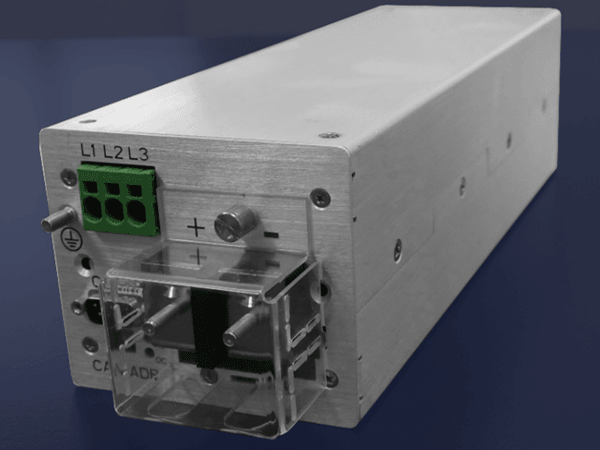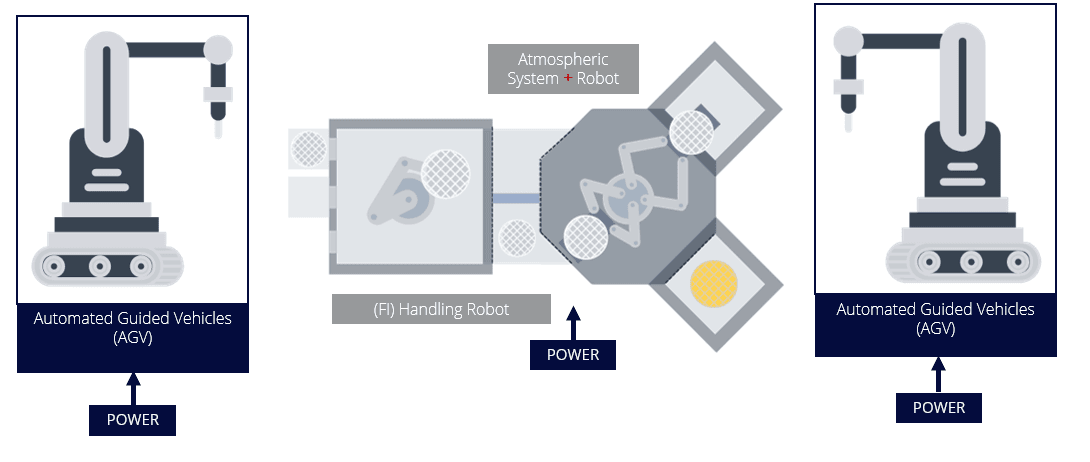Silicon Carbide Makes for Smarter Semi Fab/Process Power Supplies
Article
Semiconductor device fabrication processes have several distinct and intricate steps. Power supplies used in semiconductor fab equipment are essential for every task at the front and back end of the process. Due to its power density, reliability, and design flexibility, engineers are seeing the benefits of using Silicon Carbide (SiC) compared with silicon-based power supplies in applications where it hasn’t been used before.
Power density and flexibility are why Wolfspeed and Astrodyne TDI (ATDI) joined forces to exploit the benefits of SiC technology to meet the diverse power supply needs of modern semiconductor fab/process equipment. Our combined efforts have enabled higher power density through the adoption of SiC devices, most notably with ATDI’s new Kodiak power supply platform, which achieves a power density of 40 W/in3. Specifically, Wolfspeed’s long history in developing robust SiC-based solutions is helping ATDI provide better power converters, which in turn help customers improve process control.
Power supplies are an end-to-end requirement
Power supplies are required in a wide variety of equipment involved in the semiconductor fab/process.
One key area is testing. As semiconductor device fabrication processes turn silicon into a thin wafer containing tiny functional circuits, the wafers are cut into individual chips known as dies. Each integrated circuit gets tested prior to die singulation, including testing at high temperature to ensure proper function at the parts’ specified ratings. Power is critical to this process, wherein power levels can be quite high and noise levels must be very low.
Power supplies also play a role with implantation, which involves introducing ions of a particular element into a material to change or refine their properties. Also known as “semiconductor doping,” implantation involves ions — also called dopants — of boron, phosphorus, or arsenic, which introduce impurities to modulate the device’s electronic properties. A successful implantation process requires high-energy electron beams created by equipment that must have a dependable power supply to both generate the beam and then steer and focus it via electromagnets.

Etching and deposition equipment in semiconductor fabrication also require a reliable source of power. Both wet and dry etching transforms a thin film of material into circuit interconnects and other essential components. Using photolithography, the etching process removes extraneous material, leaving only the intricate circuit patterns behind. Consistent electrical power is also necessary for deposition, which involves using evaporation or sputtering techniques to create the various metal layers that form electrical connections between cells, maintaining the uniformity of the deposited material to create even layers.
Many power converters utilized in these tools are integral parts of the semiconductor fabrication process, wherein the converter is required to be more than just a consistent source of voltage. Power supplies may be required to dynamically control their delivered power or current to high degrees of precision. Historically, many of these supplies utilize AC-line-frequency–based converters due to their ability to be configured for varying AC voltages often found in fabs worldwide, ranging from 100 to 480 VAC. The advent of SiC technology has enabled these applications to be serviced by high-frequency switch-mode (HFSM) converters, which offer significant advantages in performance and power density.
All of these processes benefit from higher-density power supplies located as close to the actual tool as possible; processes become inherently tighter with enhanced precision, reduced complexity, and reduced process time that translates into a faster time to market. HFSM power supplies leveraging SiC technology afford greater flexibility to those building power supplies for semiconductor fabrication equipment.
Finding a balance between power density and flexibility
ATDI has been using second-generation SiC devices for its power supplies for nearly a decade and has migrated to third-generation devices in the Kodiak platform to provide a standard building block that can be integrated into many custom solutions.
By adapting the latest SiC technology, ATDI has improved power density to solve customers’ high-complexity problems. The industry-leading 40-W/in3 power density achieved in the Kodiak product is enabled by the low losses in the SiC MOSFETs and associated body diodes, which allowed for highly efficient and flexible power topologies to be selected.
Along with high density, Kodiak is compatible with global AC power sources and provides high precision control of delivered voltage, current, or power. The power topology shown below utilizes a three-phase power-factor–correction AC/DC stage and a phase-shift full-bridge (PSFB) isolated DC/DC stage. The AC/DC stage can operate over a wide operating window of input voltages and frequencies, making it easier for end-equipment manufacturers to utilize just two different models globally. Additionally, the DC/DC stage is implemented with a PSFB, which provides controllability across a wider range of output voltages and power levels compared with resonant converters. These two topologies would not be practical to implement with a traditional silicon MOSFET or IGBT, but Wolfspeed SiC MOSFETs are up to the challenge.
Getting power closer to the process
Smaller, more compact power converters provide advantages to semi fab equipment manufacturers. High density enables them to locate a power supply closer to the tool and the actual process, which enables improved process consistency and repeatability. However, locating power converters close to the tool creates other issues that must be addressed. Perhaps the most challenging issue is converter cooling, which is complicated by the prohibition of forced air cooling from clean rooms. ATDI has a long history of providing high-efficiency, liquid-cooled converters specifically designed to address this issue while improving reliability by eliminating fans.

With their exceptionally fast switching speed, coupled with extremely low conduction losses, Wolfspeed SiC technology has enabled ATDI converters to feature high-switching–frequency designs operating from wide-range AC power sources. Furthermore, Wolfspeed packaging technology has facilitated the Kodiak platform’s industry-leading, liquid-cooled design topology.
ATDI’s Kodiak platform is the result of a close collaboration between ATDI and Wolfspeed. Rather than simply taking an existing silicon design and converting it to SiC, ATDI’s liquid-cooled Kodiak platform is optimized with SiC in mind to maximize power density and optimize the overall footprint. Kodiak is ideal for high-power DC systems, particularly in industrial and military applications requiring automatic load sharing, a wide DC operating voltage range, and international power input, as well as high operating efficiency, excellent reliability, compact size, and easy maintenance.
Complexity is reduced and reliability is enhanced through more efficient cooling, which is a key differentiator in Kodiak. The ever-increasing power demands of industrial process requirements, data processing and communication networks, and military systems have demonstrated a compelling need for cost-effective, reliable liquid-cooled power-conversion systems. ATDI’s Kodiak provides a robust, building-block approach to serving these needs.

Ultimately, the combination of smart cooling, better switching, and reduced size allows for power converters in semiconductor fabrication tools that are more flexible because the power supply can be located close to the process itself. By closing the proximity gap, precision is vastly improved, which in turn has a direct, positive impact on process performance.
Silicon Carbide-based power solutions deliver density and flexibility
The wide range of models that ATDI can offer with fully adjustable outputs and multiple control modes provides ultimate application flexibility and reduces time to market for applications in a semiconductor fabrication environment. By taking advantage of SiC’s power density, reliability, output, and design flexibility where it’s not been used previously, ATDI can provide the power converters that are essential for every task at the front end and back end of any semiconductor fabrication process.
Learn more about Wolfspeed Silicon Carbide Power Products and ATDI Kodiak Power Supplies.